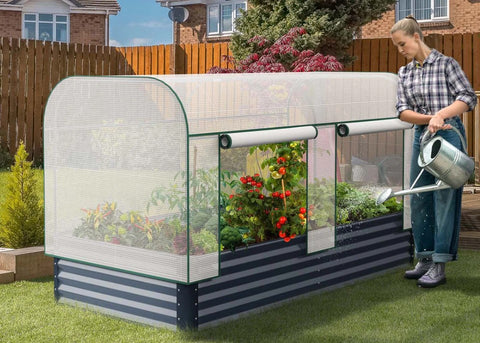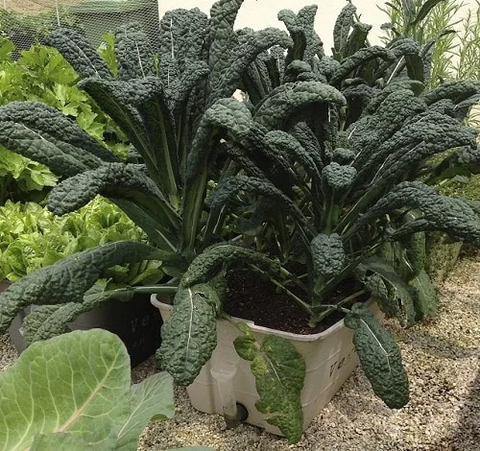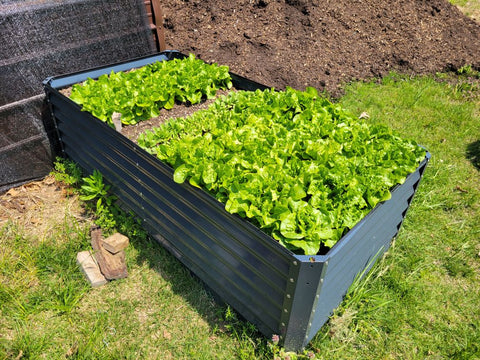In the world of gardening, there's a growing trend that combines the best of both worlds: aesthetics and productivity. It's called edible landscaping, and it's a clever way to transform your yard into a beautiful and bountiful space. Edible landscaping is all about seamlessly integrating food-producing plants into your garden's design, and one of the most effective ways to do this is by using raised garden beds. In this blog, we'll explore the art of edible landscaping with raised beds and how you can elevate your outdoor space into a lush, productive, and beautiful oasis.The following content also has some reference value for raised garden beds.

Why Choose Raised Garden Beds for Edible Landscaping?
Raised garden beds, often in the form of elevated boxes or mounded soil, have become a preferred choice for edible landscaping. Here's why:
- Enhanced Soil Control: Raised beds allow you to have better control over your soil composition. You can tailor the soil to suit the specific needs of the plants you intend to grow.
- Improved Drainage: Raised beds typically have better drainage, which is crucial for preventing waterlogged soil and root rot.
- Elevated Aesthetics: Raised beds can be designed in various shapes and sizes, adding a touch of architectural elegance to your garden.
- Less Bending and Stooping: The elevated design of raised beds means less bending and stooping, making gardening more accessible to all.
Plant Selections for Your Edible Landscape
Now, let's delve into the exciting world of plants that can grace your garden beds in your edible landscape:

- Herb Haven: Culinary herbs like basil, rosemary, and thyme are not only flavorful but also ornamental. Plant them in raised beds for easy access and a fragrant garden.
- Colorful Salad Greens: Mix various lettuces, kale, and Swiss chard are excellent choices for raised beds. They provide a continuous supply of fresh, nutritious greens and a patchwork of vibrant greens in your garden.
- Vivid Peppers: Bell peppers in red, yellow, and green, along with spicy chili peppers, add a burst of color and flavor.
- Rainbow of Tomatoes: From plump red beefsteaks to golden heirlooms, tomatoes come in an array of colors and sizes, making them a visual delight.
- Sensational Strawberries: Strawberries thrive in raised beds, and their cascading growth creates an attractive and delicious ground cover.
- Dwarf Fruit Trees: Consider a dwarf apple, pear, or cherry trees for a compact orchard in your garden.
- Compact Veggies: Choose compact varieties of cucumbers, zucchini, and squash, which are well-suited for raised beds.
- Vertical Veggies: Grow vertical crops like beans, peas, and cucumbers using trellises, maximizing your space.
- Berries: Blueberries, raspberries, and blackberries can be grown in raised beds with the right soil mix.
- Flowers: Edible flowers like nasturtiums and calendulas not only add color but can be used to garnish salads and desserts.
Designing Your Edible Landscape
- Select the Right Location: Determine the ideal location for your raised garden beds, considering sunlight, water access, and proximity to your home for easy maintenance.
- Design Your Beds: Raised garden beds can be as simple or ornate as you desire. Choose aesthetically pleasing and sustainable materials like galvanized raised beds and arrange them to complement your overall landscape.
- Layout and Spacing: Plan the layout of your raised beds, considering the growth habits and spacing requirements of your chosen crops.
- Mulching: Apply mulch to help control soil temperature, prevent weed growth, and preserve moisture.
Planting Your Edible Landscape
- Layering and Vertical Gardening: Incorporate vertical gardening elements like trellises, arches, and hanging planters to maximize your space. Plant taller crops at the back and smaller ones in the front for a layered effect.
- Succession Planting: Plan for successive crops throughout the year to ensure a continuous harvest and year-round beauty.
- Companion Planting: Implement companion planting strategies to enhance your garden's health and productivity. Certain plant combinations can help deter pests and improve soil quality.
- Decorative Elements: Add decorative elements like garden art, pathway stones, and seating areas to enhance the aesthetic appeal of your edible landscape.
Maintenance and Care

- Soil Management: Regularly amend and maintain your soil to provide essential nutrients for your plants. Mulch to retain moisture and prevent weeds.
- Pruning and Training: Keep your plants in check by pruning and training them as needed. This helps maintain the aesthetic beauty of your landscape.
- Pest and Disease Control: Monitor your garden for pests and diseases and take prompt action to prevent infestations.
- Watering: Consistent and adequate watering is crucial. Drip irrigation or soaker hoses can ensure efficient water distribution.
Harvest and Enjoy
As your edible landscape matures, the joy of harvesting your own fresh produce will be immeasurable. From vibrant salads to homemade salsas, your garden will provide a bounty of flavors for your kitchen. Create a garden-to-table experience that elevates your culinary adventures and connects you with the food you consume.
Conclusion: Transforming Your Yard into an Edible Paradise

Edible landscaping with raised garden beds is more than a trend; it's a lifestyle choice that combines the pleasure of gardening with the satisfaction of growing your food. By thoughtfully designing your garden, selecting the right crops, and incorporating elevated aesthetics, you can create a garden that not only provides sustenance but also elevates the visual appeal of your outdoor space. As you transform your yard into an edible paradise, you'll discover the joy of harvesting your bounty and savoring the flavors of your hard work.









